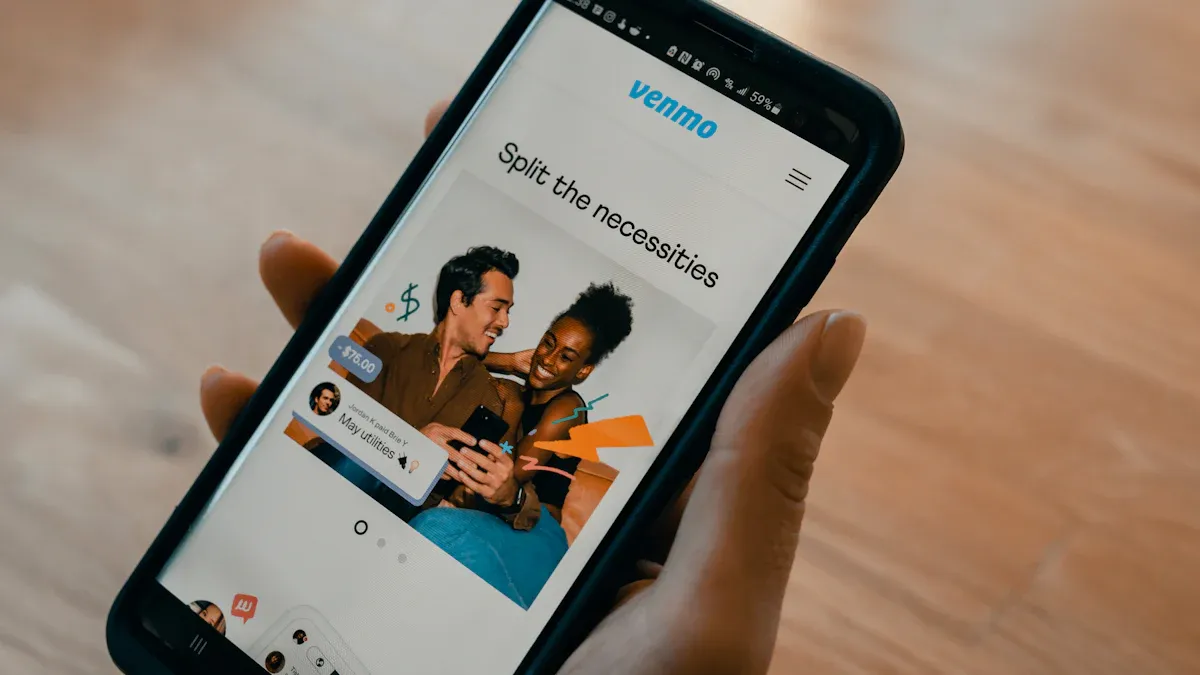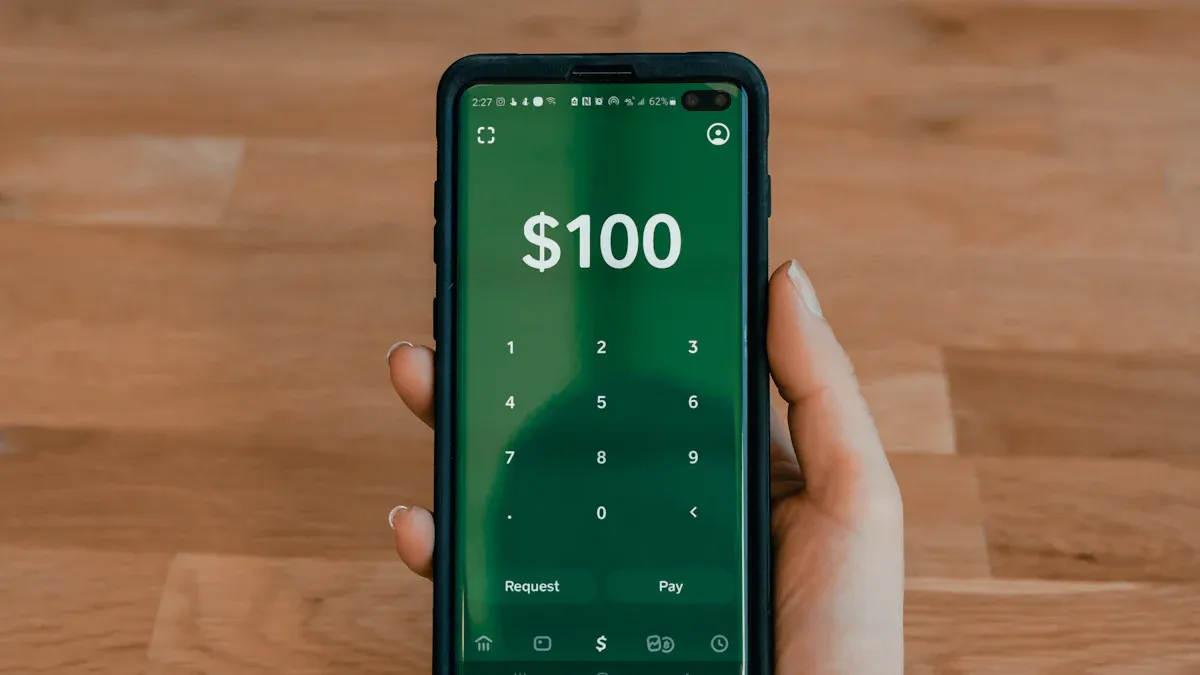- EasyCard
- Trade
- Help
- Announcement
- Academy
- SWIFT Code
- Iban Number
- Referral
- Customer Service
- Blog
- Creator
Can You Transfer Money Internationally with Venmo? Fees, Limits, and Usage Guide

Image Source: unsplash
You might be wondering if you can use Venmo to send money to friends or family overseas. The answer is clear: no. Venmo’s services are strictly limited to the United States.
This app is an extremely popular payment tool in the U.S., with a massive user base:
- As of 2025, Venmo’s total user base is expected to reach 97.1 million.
- The user base grew from 41.5 million in 2019 to this point, demonstrating its significant influence in the U.S. market.
Venmo’s success reflects the rapid growth of the U.S. P2P mobile payment market.
Please Note: While Venmo is highly convenient for domestic use in the U.S., international transfers with Venmo are currently not possible.
Key Takeaways
- Venmo can only be used within the U.S. and cannot be used for international transfers.
- Venmo does not support international transfers due to geographic restrictions, the requirement for a U.S. phone number and bank account, and its focus on U.S. domestic payments.
- Venmo domestic transfers are typically free, but instant withdrawals and credit card payments incur fees.
- PayPal, Wise, Remitly, and bank wire transfers are alternatives to Venmo for international transfers.
- Wise is usually the cheapest option for international remittance because it uses real exchange rates with transparent fees.
Venmo’s Core Restrictions: Why It Doesn’t Support International Transfers

Image Source: unsplash
You already know that Venmo cannot be used for cross-border transfers, but you may be curious about the specific reasons behind this. Venmo’s service framework is built on several core restrictions that collectively limit its operations to within the U.S. Understanding these restrictions can help you choose the right remittance tool.
Geographic Restrictions: U.S.-Only Usage
Venmo’s terms of service clearly state that users must be physically located in the U.S.. This means that if you are not in the U.S., you will be unable to register or use Venmo’s features.
Important Note: Venmo uses geolocation technology to verify users’ locations. Therefore, even if you have a U.S. account, attempting to use it abroad may result in restricted or blocked services.
Account Requirements: U.S. Phone Number Required
To successfully register and use Venmo, you must meet two basic conditions:
- Have a valid U.S. phone number.
- Link a bank account or debit card established in the U.S.
Without these, you cannot complete identity verification or fund linking, making any transfer operations impossible. This requirement inherently excludes non-U.S. users.
Design Purpose: Focused on U.S. Domestic P2P Payments
Venmo’s origin story is simple. Founded in 2009 by two college roommates, it was inspired by the need to simplify splitting bills or repaying small debts among friends. Its core goal has always been to streamline small-scale, person-to-person (P2P) transactions within the U.S., such as splitting restaurant bills or rent. Its design never accounted for complex international remittance scenarios.
Regulatory Compliance: Complexity of International Transfers
International transfers involve complex financial regulations to prevent illegal activities like money laundering. To simplify operations and comply with U.S. regulations, Venmo chooses not to engage in this area. Specifically:
- Compliance with Federal Regulations: Venmo sets transaction limits to adhere to U.S. federal remittance regulations.
- Identity Verification (KYC): To increase transfer limits, you need to verify your identity. This process follows U.S. “Know Your Customer” (KYC) regulations, typically requiring a U.S. Social Security Number (SSN), which only U.S. residents can provide.
- Focus on Domestic Market: These strict, U.S.-resident-only compliance requirements make international transfers with Venmo fundamentally impossible.
Detailed Breakdown of Venmo’s Fees and Transfer Limits

Image Source: unsplash
Important Reminder: All fees and limits discussed in this section apply only to transactions within the U.S. As previously noted, international transfers with Venmo are not possible.
Understanding Venmo’s fee structure for domestic use can help you manage your funds better. While many core features are free, certain scenarios may incur additional costs.
Personal Transfer Fees
Venmo’s basic transfer service is very user-friendly. When you pay friends or family using the following methods, Venmo charges no fees:
- Your Venmo balance
- A linked bank account
- A linked debit card
This free model is one of the main reasons for Venmo’s widespread popularity.
Withdrawal Fee Comparison
When you need to transfer your Venmo balance to your bank account, you have two options:
- Standard Transfer: This option is free, but funds typically take 1-3 business days to arrive.
- Instant Transfer: If you need funds urgently, you can choose instant transfer. Venmo charges 1.75% of the transfer amount, with a minimum fee of $0.25 and a maximum of $25. Funds typically arrive in your bank account or debit card within 30 minutes.
Credit Card Payment Fees
When you use a credit card to send money, Venmo charges a 3% transaction fee.
Please Note: In addition to Venmo’s fees, your credit card issuer may treat such transactions as a “cash advance.” This means you may incur additional fees or higher interest rates. You can check if your credit card incurs extra fees in the “Wallet” section of the Venmo app.
Venmo Transfer Limits
To comply with financial regulations, Venmo sets caps on transfer amounts. After completing identity verification, your main limits are as follows:
| Transaction Type | Limit |
|---|---|
| Person-to-Person Transfers | Up to $60,000 per week |
| Instant Transfer to Bank | Up to $50,000 per transaction |
Additionally, if you use a Venmo business profile to receive payments, the platform charges a 1.9% + $0.10 transaction fee.
Alternatives to Venmo for International Transfers
You’ve learned that Venmo cannot handle cross-border remittances. Fortunately, there are many excellent alternative tools designed specifically for international transfers, often cheaper and faster than traditional banks. Below, we introduce four mainstream alternatives to help you find the best fit for your needs.
Alternative 1: PayPal
As Venmo’s parent company, PayPal is a globally recognized payment platform. If both you and the recipient have PayPal accounts, it’s a highly convenient option.
Its main strength lies in its unparalleled global network. You can use PayPal to send money to users in over 200 countries and regions and support 25 different currencies.
However, convenience comes with higher costs. You need to be aware of PayPal’s complex fee structure:
- Transfer Fee: Sending money from the U.S. to overseas personal accounts incurs a fee of
5%of the transaction amount, with a minimum of$0.99and a maximum of$4.99. - Funding Source Fee: If you use a credit or debit card, an additional
2.9%fee plus a fixed fee applies. - Exchange Rate Markup: This is the most easily overlooked “hidden cost.” PayPal does not use the real-time mid-market exchange rate, adding about a
4%markup.
This means that even if the transfer fee seems low, you’ll lose money in the currency conversion.
For Example: When sending $1,000 to Europe, the recipient may receive dozens of euros less due to the exchange rate markup compared to other platforms.
Alternative 2: Wise
Wise (formerly TransferWise) is a fintech company focused on providing transparent, low-cost international remittance services. Its core advantage lies in its fair pricing model.
Wise promises not to profit from exchange rate markups, offering you the real mid-market exchange rate.
- What is the Mid-Market Exchange Rate? This is the real rate you see on Google or Reuters, used between banks and traders, without any hidden markups.
- Full Transparency: Before transferring, Wise clearly shows the fixed fee, the exchange rate used, and the exact amount the recipient will receive.
- Avoiding the “Zero Fee” Trap: Many services claim “zero fees” but hide profits in poor exchange rates. Wise separates fees and rates, letting you know exactly where your money goes.
Wise’s Philosophy: “We use the real mid-market rate, with no sneaky markups to hide fees.”
If you seek the lowest costs and highest transparency, Wise is almost always the top choice for international transfer needs from Venmo.
Alternative 3: Remitly
Remitly’s standout feature is its highly flexible delivery options. It’s particularly suitable for sending money to family or friends in areas with limited banking services or those who prefer cash.
Remitly offers two types of transfer services, allowing you to choose based on your needs:
| Service Type | Transfer Time |
|---|---|
| Express (Fast) | Typically arrives within minutes |
| Economy (Low-Cost) | Takes 3-5 business days, but fees are lower |
Its greatest strength lies in its extensive delivery network. Recipients can receive funds through various methods:
- Bank account deposits
- Mobile wallets (e.g., M-Pesa, GCash)
- Cash pickup at thousands of partner locations
- Home delivery (available in some countries)
This flexibility makes Remitly a very user-friendly option, especially in emergencies or when recipients lack bank accounts.
Alternative 4: Bank Wire Transfer
Bank wire transfers are the most traditional method for international remittances. Despite the rise of modern alternatives, wire transfers still have value in certain scenarios, particularly for large transactions. Whether operated through U.S. banks or international financial centers like Hong Kong, the process is largely similar.
Its main advantage is security and reliability. Bank systems are time-tested, ideal for handling large sums with high security requirements.
However, these advantages come at the cost of high fees and slow speeds.
- High Fees: The average sending bank fee for an international wire transfer is about
$44. However, this isn’t the full cost—you also need to consider intermediary bank fees, receiving bank fees, and a2-4%markup added to the exchange rate. A $1,000 transfer could easily cost over$55in total. - Slow Speed: International wire transfers typically take 1-5 business days to complete, depending on time zones, holidays, and the number of banks involved.
In summary, unless you need to handle a large transaction with stringent security requirements, bank wire transfers are usually not the most cost-effective option.
Comparison of International Transfer Options
To help you make a clearer choice, the table below summarizes the key features of the four alternatives. While international transfers with Venmo are not feasible, these tools can perfectly meet your needs.
| Option | Core Advantage | Fee Structure | Exchange Rate | Delivery Speed | Best For |
|---|---|---|---|---|---|
| PayPal | Large global user base, convenient | Transfer fee + funding source fee + rate markup | Poor, ~4% markup | Typically instant (between PayPal accounts) | Paying friends with PayPal or business transactions |
| Wise | Transparent, low-cost | Low fixed fees | Excellent, uses mid-market rate | Minutes to 2 business days | Lowest cost and best rates, ideal for most personal transfers |
| Remitly | Flexible delivery options | Fast or economy options with varying fees | Average, includes markup | Minutes to 3-5 business days | Recipients without bank accounts or needing cash/mobile wallet |
| Bank Wire Transfer | Secure, reliable, supports large amounts | High fees (sender + intermediary + receiver) | Poor, 2-4% markup | Slow, 1-5 business days | Large, high-security transactions, regardless of cost or time |
You need to remember that Venmo is an excellent domestic payment tool in the U.S. but cannot handle international transfers. Now, you can choose from the discussed options based on your specific needs:
- Seeking Lowest Costs and Best Rates: Wise is your top choice.
- Valuing Convenience and Multiple Delivery Options: PayPal and Remitly are worth considering.
- Handling Large Transactions with Security First: Bank wire transfers remain a reliable option.
We hope this comparison helps you find the most suitable international transfer method.
FAQ
Can I Use a VPN to Pretend I’m in the U.S. for Venmo International Transfers?
You should not do this. Venmo uses multiple technologies to verify your location. Even if you temporarily bypass restrictions, your account is highly likely to be frozen or closed for violating the terms of service, leading to potential fund losses.
Can Funds Be Transferred Between Venmo and PayPal Accounts?
No. Although PayPal is Venmo’s parent company, they are two separate services. You cannot directly transfer funds between the two platforms. You’d need to withdraw money from Venmo to a bank account and then deposit it into PayPal.
Which International Transfer Alternative Is the Cheapest?
If you prioritize the lowest fees and best exchange rates, Wise is typically the most cost-effective option. It uses the real mid-market exchange rate with fully transparent fees, helping you maximize savings.
Does the Recipient Need a U.S. Bank Account for International Transfers?
No. When using services like Wise, Remitly, or bank wire transfers, the recipient only needs to provide valid bank account details in their country/region. Remitly even supports cash pickup without a bank account.
*This article is provided for general information purposes and does not constitute legal, tax or other professional advice from BiyaPay or its subsidiaries and its affiliates, and it is not intended as a substitute for obtaining advice from a financial advisor or any other professional.
We make no representations, warranties or warranties, express or implied, as to the accuracy, completeness or timeliness of the contents of this publication.




Contact Us
Company and Team
BiyaPay Products
Customer Services
is a broker-dealer registered with the U.S. Securities and Exchange Commission (SEC) (No.: 802-127417), member of the Financial Industry Regulatory Authority (FINRA) (CRD: 325027), member of the Securities Investor Protection Corporation (SIPC), and regulated by FINRA and SEC.
registered with the US Financial Crimes Enforcement Network (FinCEN), as a Money Services Business (MSB), registration number: 31000218637349, and regulated by FinCEN.
registered as Financial Service Provider (FSP number: FSP1007221) in New Zealand, and is a member of the Financial Dispute Resolution Scheme, a New Zealand independent dispute resolution service provider.




















